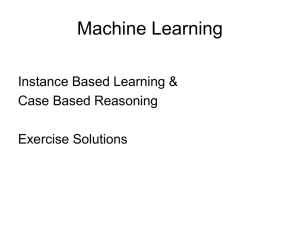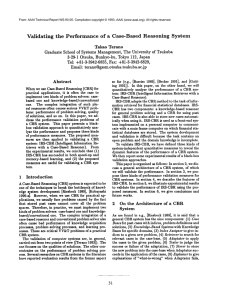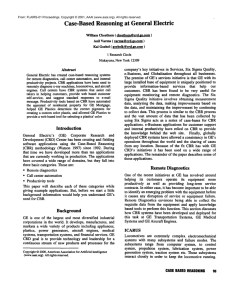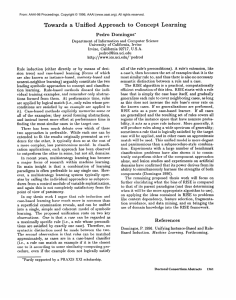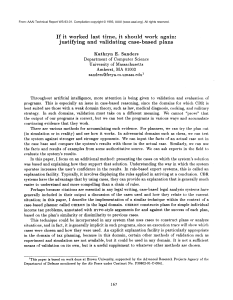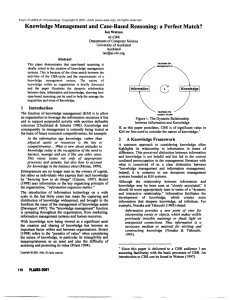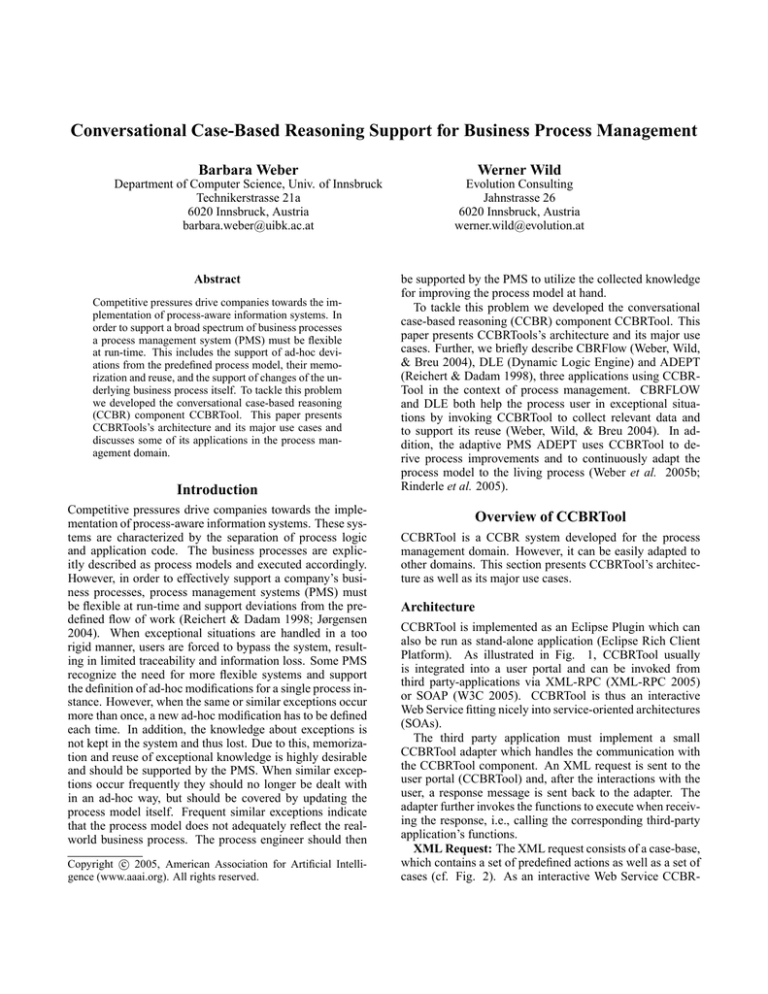
Conversational Case-Based Reasoning Support for Business Process Management
Barbara Weber
Werner Wild
Department of Computer Science, Univ. of Innsbruck
Technikerstrasse 21a
6020 Innsbruck, Austria
barbara.weber@uibk.ac.at
Evolution Consulting
Jahnstrasse 26
6020 Innsbruck, Austria
werner.wild@evolution.at
Abstract
Competitive pressures drive companies towards the implementation of process-aware information systems. In
order to support a broad spectrum of business processes
a process management system (PMS) must be flexible
at run-time. This includes the support of ad-hoc deviations from the predefined process model, their memorization and reuse, and the support of changes of the underlying business process itself. To tackle this problem
we developed the conversational case-based reasoning
(CCBR) component CCBRTool. This paper presents
CCBRTools’s architecture and its major use cases and
discusses some of its applications in the process management domain.
Introduction
Competitive pressures drive companies towards the implementation of process-aware information systems. These systems are characterized by the separation of process logic
and application code. The business processes are explicitly described as process models and executed accordingly.
However, in order to effectively support a company’s business processes, process management systems (PMS) must
be flexible at run-time and support deviations from the predefined flow of work (Reichert & Dadam 1998; Jørgensen
2004). When exceptional situations are handled in a too
rigid manner, users are forced to bypass the system, resulting in limited traceability and information loss. Some PMS
recognize the need for more flexible systems and support
the definition of ad-hoc modifications for a single process instance. However, when the same or similar exceptions occur
more than once, a new ad-hoc modification has to be defined
each time. In addition, the knowledge about exceptions is
not kept in the system and thus lost. Due to this, memorization and reuse of exceptional knowledge is highly desirable
and should be supported by the PMS. When similar exceptions occur frequently they should no longer be dealt with
in an ad-hoc way, but should be covered by updating the
process model itself. Frequent similar exceptions indicate
that the process model does not adequately reflect the realworld business process. The process engineer should then
c 2005, American Association for Artificial IntelliCopyright °
gence (www.aaai.org). All rights reserved.
be supported by the PMS to utilize the collected knowledge
for improving the process model at hand.
To tackle this problem we developed the conversational
case-based reasoning (CCBR) component CCBRTool. This
paper presents CCBRTools’s architecture and its major use
cases. Further, we briefly describe CBRFlow (Weber, Wild,
& Breu 2004), DLE (Dynamic Logic Engine) and ADEPT
(Reichert & Dadam 1998), three applications using CCBRTool in the context of process management. CBRFLOW
and DLE both help the process user in exceptional situations by invoking CCBRTool to collect relevant data and
to support its reuse (Weber, Wild, & Breu 2004). In addition, the adaptive PMS ADEPT uses CCBRTool to derive process improvements and to continuously adapt the
process model to the living process (Weber et al. 2005b;
Rinderle et al. 2005).
Overview of CCBRTool
CCBRTool is a CCBR system developed for the process
management domain. However, it can be easily adapted to
other domains. This section presents CCBRTool’s architecture as well as its major use cases.
Architecture
CCBRTool is implemented as an Eclipse Plugin which can
also be run as stand-alone application (Eclipse Rich Client
Platform). As illustrated in Fig. 1, CCBRTool usually
is integrated into a user portal and can be invoked from
third party-applications via XML-RPC (XML-RPC 2005)
or SOAP (W3C 2005). CCBRTool is thus an interactive
Web Service fitting nicely into service-oriented architectures
(SOAs).
The third party application must implement a small
CCBRTool adapter which handles the communication with
the CCBRTool component. An XML request is sent to the
user portal (CCBRTool) and, after the interactions with the
user, a response message is sent back to the adapter. The
adapter further invokes the functions to execute when receiving the response, i.e., calling the corresponding third-party
application’s functions.
XML Request: The XML request consists of a case-base,
which contains a set of predefined actions as well as a set of
cases (cf. Fig. 2). As an interactive Web Service CCBR-
Third-Party Application
Response
CBRFLOW
DLE
Figure 1: High-level Architecture
Request
<REQUEST>
<CASEBASE ID="1">
<ACTIONS>
<!-- This section has to be specified for each
application to support automated actions -->
</ACTIONS>
<CASES>
...
</CASES>
</CASEBASE>
</REQUEST>
Response
Tool receives the XML request and presents its GUI which
is initialized according to the case-base in the request.
<RESPONSE>
<CASEBASE ID="1">
<CASE>
...
</CASE>
</CASEBASE>
<PERFORM_ACTION/>
</RESPONSE>
Problem
ADEPT
<CASE ID="71">
…
<NAME>Dangerous Goods</NAME>
<DESCRIPTION>Shipment must be labeled when articles classified as
'dangerous goods' are contained in the shipment. </DESCRIPTION>
Question-Answer Pairs
XML-RPC
SOAP
e.g.,
CCBR Adapter
Request
<QAPAIRS>
<QAPAIR>
<QUESTION ID="110">Dangerous goods in shipment?</QUESTION>
<ANSWER ID="129">Yes</ANSWER>
</QAPAIR>
<QAPAIR>
<QUESTION ID="109">Do dangerous goods exceed legal
limits?</QUESTION>
<ANSWER ID="128">Yes</ANSWER>
</QAPAIR>
</QAPAIRS>
Action
CCBRTool
<ACTION_TO_PERFORM ID="MANUAL">
<SHORT_DESCRIPTION>Label as dangerous goods, declare chemicals
</SHORT_DESCRIPTION>
<DESCRIPTION></DESCRIPTION>
</ACTION_TO_PERFORM>
Case History
User Portal
<HISTORY>
<HISTORY_ENTRY TYPE="CREATE" ID="11279" >
<TIMESTAMP>2005-07-10 12:27:06</TIMESTAMP>
<USER>Tammy Traveller</USER>
</HISTORY_ENTRY>
<HISTORY_ENTRY TYPE="EVALUATE" ID="12346">
<TIMESTAMP>2005-07-11 17:44:00</TIMESTAMP>
<USER>Tammy Traveller</USER>
<FEEDBACK>
<GRADE>HIGHLY POSITIVE</GRADE>
<COMMENT>The shipment of small propane gas containers
to Switzerland worked fine by reusing the
case</COMMENT>
</FEEDBACK>
</HISTORY_ENTRY>
<HISTORY_ENTRY TYPE="EVALUATE" ID="12935">
<TIMESTAMP>2005-07-15 11:51:00</TIMESTAMP>
<USER>John Miller</USER>
<FEEDBACK>
<GRADE>HIGHLY POSITIVE</GRADE>
<COMMENT>I applied the case successfully to the
shipment of hairspray within the EU.</COMMENT>
</FEEDBACK>
</HISTORY_ENTRY>
</HISTORY>
</CASE>
Figure 2: XML Request and Response
Figure 3: Case Representation
Predefined actions are application dependent, they have
to be specified for each invocation of CCBRTool and are
transmitted in the request. Thereby only actions which are
supported in the current context of the third-party application and for which the user is authorized should be included
in the request. In addition, CCBRTool allows for manual actions to document actions the user performs when bypassing
the system (e.g., to deal with exceptions).
XML Response: The XML response consists of the
selected/modified case and a meta-action, e.g., PERFORM ACTION or DELETE CASE ACTION (cf. Fig. 2).
Case Representation: Within CCBRTool a case consists
of a textual problem description, a set of question-answer
pairs and an action to perform (i.e., a manual action or an
automated action from the list of predefined actions). In
addition, each case keeps its history (cf. Fig. 3) to foster
traceability.
Major Use Cases
The major use cases supported by CCBRTool are:
•
•
•
•
•
•
Retrieve Case
Show Case
Add New Case
Apply Case
Evaluate Case
Show Feedback
• Edit Case
• Delete Case
• Adapt Case
Retrieve Case: After opening CCBRTool the graphical
user interface for retrieving similar cases pops up (cf. Fig
4). For case retrieval the standard CCBR problem-solving
process as described in (Aha, Breslow, & Muñoz-Avila
2001) has been slightly adapted. The system presents the
user with the set of unanswered questions of all cases in the
case-base, ranked by their occurrence frequency. The user
can answer any of the displayed questions in arbitrary order and/or filter the case-base by applying a full-text search.
The system then calculates the similarity of all cases in the
filtered case-base and displays a list of cases ranked by their
similarity. Cases which do not match the filter criteria are
omitted. Similarity is calculated by dividing the number of
correctly answered questions by the total number of questions in the case. The questions are then re-ranked based on
the retrieved cases and displayed. The user can continue to
answer questions until a suitable case is found or abort the
dialog when the system fails to find a similar enough case.
Show Case: A selected case can be displayed in detail,
the case (problem description, question-answer pairs and actions) and its full history is shown (cf. Fig. 5).
Figure 4: Case Retrieval
Figure 6: Adding a New Case
Figure 5: Case History
Add Case: When CCBRTool fails to retrieve a similar
enough case, a new case can be added to the system (cf. Fig.
6). For this, the user enters a textual problem description,
a set of question-answer pairs and a solution part (i.e., action). Additional administrative attributes like creation date
are added by the system.
In order to avoid multiple similar question-answer pairs
with the same semantics are entered more than once, users
are encouraged to reuse question-answer pairs from existing
cases. Question-answer pairs can be entered by either selecting already existing question from a list or, when the system
has no suitable question yet, by defining a new question and
giving the appropriate answer. CCBRTool intentionally allows the user to specify question-answer pairs using natural
language and does not use controlled vocabularies. A given
controlled vocabulary only allows to express those things the
vocabulary is designed to capture, which is not feasible for
handling unexpected exceptions. To prevent uncontrolled
growth of the case-base the process engineer should review
and consolidate the case-base from time to time.
Actions can be either manual or automated. On the one
hand, manual actions simply describe the solution in a textual way, their execution does not include any system supported actions. Manual actions are especially useful when
tasks have to be performed which are not (yet) directly sup-
ported by the third-party system (e.g., to deal with an exception). On the other hand, automated actions are performed
by the third-party application (e.g., skipping an activity in a
business process). The application dependent list of actions
to select from is sent to CCBRTool in the XML request.
Apply Case: When a similar enough case has been found,
or a new case has been added to the case-base, its solution
can be applied. For this, a response message including the
action to be performed is returned by CCBRTool. In case of
a manual action a textual description of the solution is presented to the user who can then resolve the problem by performing the described manual steps. For automated actions
the requesting third-party system automatically performs the
action specified in the response message.
Evaluate Case: Whenever a case is applied, a work item
is generated to evaluate the case’s performance later on. As
cases are added to the system by end users and not by a
process engineer, evaluation mechanisms are needed to keep
the quality of the cases in the case-base sufficiently high.
Although this can not prevent adding low quality cases to the
case-base, it can at least ensure that such cases are not reused
by other users. Negative feedback results in an immediate
notification of the process engineer, who can then repair the
case or deactivate it to prevent its further reuse.
As illustrated in Fig. 7 the user can rate the performance
of the respective case either with highly positive (2), positive
(1), neutral (0), negative (-1) or highly negative (-2), and
may optionally enter textual comments too.
Show Feedback: The detailed feedback of a case can be
displayed by right-clicking the reputation score in the display list of cases (cf. Fig. 4). The reputation score in com-
Adapt Case: When editing a case the original case is
modified. In contrast, when adapting a case a copy of the
original case is made which can then be modified. This functionality can be used to quickly add cases to the case-base,
when they are similar to already existing ones (e.g., same
problem description and solution, but different questionanswer pairs).
Applications of CCBRTool
This section presents the three systems CBRFlow, DLE
and ADEPT, our current applications of CCBRTool in the
process management domain.
CBRFlow
Figure 7: Evaluate Case
bination with the reuse counter indicates how successfully
a case has been applied in the past. The reputation score is
calculated as the sum of the feedback scores (cf. Fig. 8).
In addition to the overall reputation score, plus some simple
statistics a table with the scores for the past six month, the
past month and the past week is displayed. Upon request the
textual comments can be displayed as well.
CBRFlow (Weber, Wild, & Breu 2004) is a research prototype of a PMS developed at the University of Innsbruck.
Within CBRFlow, CCBRTool is used to memorize knowledge about exceptions and to allow process users to deviate
from the predefined process model. CBRFlow supports the
continuous evolution of the process model by updating the
business rules in the process model when necessary. When
the process knowledge encoded in cases is reused frequently,
it should be extracted by the process engineer and be described directly in the process model to allow for full automation.
DLE
DLE (Dynamic Logic Engine) is a user-friendly programming environment for domain experts (e.g., in the logistics industry), developed by the Austrian software company VISION-FLOW. Using DLE, business logic can be extracted from application systems (e.g., ERP packages) into
an easy to maintain environment. CCBR enables the interactive selection of predefined executable components in unforeseen situations. In DLE, like in CBRFlow, CCBRTool is
used for the memorization and the reuse of knowledge about
exceptions. Automated actions as well as manual actions are
supported.
ADEPT
Figure 8: Show Feedback
Edit Case: Editing a case is only allowed for administrators to correct typos or other mistakes. In order to ensure
traceability a history entry is written when a case is modified.
Delete Case: Cases which have not proven successful or
have become obsolete over time can be deactivated by the
system’s administrator. Deactivated cases can no longer be
applied to solve new problems; however, they are not removed from the case-base to foster traceability and learning
from failure.
ADEPT (Reichert & Dadam 1998) is an adaptive PMS
which has been developed at the University of Ulm. It supports ad-hoc modifications (i.e., process instance changes)
as well as changes of the underlying business process (i.e.,
process type changes).
Currently we work on the full integration of CCBRTool
into ADEPT to support the whole process lifecycle in an
integrated way (cf. Fig 9) (Weber et al. 2005a; 2005b;
Rinderle et al. 2005).
The following describes the process life cycle as supported by ADEPT. At buildtime an initial computerized representation of a company’s business processes is created either by business process analysis or by applying process
mining techniques (i.e., by observing process and task executions) (1). At run-time new process instances are created from these predefined process models (2). Process instances are then executed according to the process model
Pr. Model M‘:
A
B
Make
Ente
Pr. Model
M:
appointm
r Make
appointm
ent
orde
Ar B
ent C
C
D
E
Inform
Examine
patient
patient
D
E
h
d
e
Process Instance I
Ad-hoc changed Process
Instance I
A
B
C
Pr
o
ce
s
s
c
tio
n
del
Mo
Ex
ec
u
s
ces
Pro
ate
Cre
Process
Engineer
l
de
Mo
Instantiation
g
an
Ch
ss
ce
ro
eP
X
Process
Participant
Conclusion
f
D
stantiated for a large number of process instances, i.e., many
process instance are started according to the same process
model (template).
CCBRTool esentially adapts the standard CCBR problemsolving process as described in (Aha, Breslow, & MuñozAvila 2001). Taxonomic (Gupta, Aha, & Sandhu 2002;
Gupta 2001) or causal CCBR (Gupta & Aha 2002) are extensions of standard CCBR, but are currently not used in
CCBRTool.
Case-Base
Ad-hoc Change
of Process Instance
by Adding (4a) or Reusing Cases (4b)
g Notify Process Engineer (frequent deviation)
Figure 9: Integrated Process Lifecycle Support
they were derived from and activities are allocated to authorized process participants to perform the respective tasks (3).
However, when deviations from the predefined model become necessary at the process instance level (e.g., due to exceptions), process participants must be able to deviate from
the model. They can either specify a new ad-hoc deviation
and document the reasons for the changes in a case-base (4
a), or reuse a previously specified ad-hoc modification from
the case-base (4 b). The PMS monitors how often a particular model is instantiated and how frequently cases are
reused. When a particular ad-hoc modification is reused frequently, the process engineer is notified that a process type
change should be performed (5). The process engineer can
then evolve the process model, and, as far as possible, migrate running instances, with help from ADEPT, to the new
model version (6). The associated case-base has to be migrated as well; cases which get directly integrated into the
new process model version are no longer needed and can be
deactivated in the case-base. All other cases are still kept
active in the case-base.
Related Work
Several other approaches combine process management and
case-based reasoning. CBR has been used to support process
modeling (Kim, Suh, & Lee 2002; Madhusudan & Zhao
2003) and ad-hoc planning (Fremann, Maximini, & Sauer
2005), it has been applied to the configuration of complex
core processes (Wargitsch 1998) and to the handling of exceptions (Luo et al. 2000). However, all of these approaches
apply traditional CBR, to our best knowledge there are no
other applications of CCBR to process management.
AI planning, especially mixed-initiative case-based planning (e.g., NaCoDAE/HTN (Muñoz-Avila et al. 1999), MICBP (Veloso, Mulvehill, & Cox 1997), SiN (Muñoz-Avila
et al. 2001) and HICAP (Muñoz-Avila et al. 2002)) can
be seen as complementary to our approach, as we primarily
focus on the execution of processes and not on modeling or
planning. In contrast to AI planning, a process model is in-
CCBRTool is a CCBR system currently tailored to process
management but can easily be adapted to other domains as
well. Within CBRFlow and DLE CCBRTool is used to support the user to deviate from the predefined process model,
to describe her deviations and to reuse the knowledge in
similar future situations. The process engineer is not supported in abstracting the knowledge encoded in cases and in
improving the process model. However, in ADEPT (with
CCBRTool) the process engineer will be notified when case
usage exceeds a predefined threshold value and will be assisted in migrating both the process model and the corresponding case-base.
Our ongoing research focuses on the integration of adaptive process management technology and CCBR. We currently work on the implementation of a prototype which
combines the methods and concepts provided by ADEPT
and CCBRTool. We further plan a thorough evaluation of the
integrated system in different application settings, including
healthcare processes and emergent workflows (e.g., in the
automotive sector).
To prevent unauthorized changes to the process model we
are also working on the implementation of an access control
model (as a Web Service) and its integration into the adaptive PMS ADEPT and CBRFlow.
References
Aha, D. W.; Breslow, L.; and Muñoz-Avila, H. 2001.
Conversational case-based reasoning. Applied Intelligence
14(1):9–32.
Fremann, A.; Maximini, R.; and Sauer, T. 2005. Towards collaborative agent-based knowledge support for agile projects. In WM2005: Professional Knowledge Management Experiences and Visions, 383–388.
Gupta, K., and Aha, D. W. 2002. Causal query elaboration
in conversational case-based reasoning. In Proceedings of
the Fifteenth Conference of the Florida AI Research Society.
Gupta, K.; Aha, D. W.; and Sandhu, N. 2002. Exploiting taxonomic and causal relations in conversational case
retrieval. In Proceedings of the 6th European Conference,
ECCBR02.
Gupta, K. 2001. Taxonomic case-based reasoning. In Proceedings of the Fourth International Conference of CaseBased Reasoning, ICCBR05, 219–233.
Jørgensen, H. D. 2004. Interactive Process Models. Ph.D.
Dissertation, Norwegian University of Science and Technology, Trondheim, Norway.
Kim, J.; Suh, W.; and Lee, H. 2002. Document-based
workflow modeling: a case-based reasoning approach. Expert Systems with Applications 23(2):77–93.
Luo, Z.; Sheth, A.; Kochut, K.; and Miller, J. 2000. Exception handling in workflow systems. Applied Intelligence
13(2):125–147.
Madhusudan, T., and Zhao, J. 2003. A case-based framework for workflow model management. In Proc. BPM’03,
354–369.
Muñoz-Avila, H.; McFarlane, D.; Aha, D.; Ballas, J.; Breslow, L.; and Nau, D. 1999. Using guidelines to constrain
interactive case-based htn planning. In Proceedings of the
Third International Conference on Case-Based Reasoning,
288–302.
Muñoz-Avila, H.; Aha, D.; Nau, D.; Breslow, L.; Weber,
R.; and Yamal, F. 2001. Sin: Integrating case-based reasoning with task decomposition. In Proc. IJCAI-2001, 99–
104.
Muñoz-Avila, H.; Gupta, K.; Aha, D.; and Nau, D. 2002.
Knowledge Management and Organizational Memories.
Kluwer Academic Publishers. chapter Knowledge Based
Project Planning.
Reichert, M., and Dadam, P. 1998. ADEPTf lex - supporting dynamic changes of workflows without losing control.
JIIS 10(2):93–129.
Rinderle, S.; Weber, B.; Reichert, M.; and Wild, W. 2005.
Integrating process learning and process evolution - a semantics based approach. In Int. Conference on Business
Process Management 2005.
Veloso, M.; Mulvehill, A.; and Cox, M. 1997. Rationalesupported mixed-initiative case-based planning. In Proceedings of the Ninth conference on Innovative Applications of Artificial Intelligence, 1072–1077.
W3C. 2005. http://www.w3.org/tr/soap/.
Wargitsch, C.
1998.
Ein Beitrag zur Integration
von Workflow- und Wissensmanagement unter besonderer
Berücksichtigung komplexer Geschäftsprozesse. Ph.D.
Dissertation, Erlangen.
Weber, B.; Reichert, M.; Rinderle, S.; and Wild, W. 2005a.
Towards a framework for the agile mining of business
processes. In Proc. of Int’l BPI workshop.
Weber, B.; Rinderle, S.; Wild, W.; and Reichert, M. 2005b.
CCBR–driven business process evolution. In Int. Conference on Case-Based Reasoning (ICCBR’05).
Weber, B.; Wild, W.; and Breu, R. 2004. CBRFlow: Enabling adaptive workflow management through conversational case-based reasoning. In Proc. Eurpean Conf. on
Case–based Reasoning (ECCBR’04), 434–448.
XML-RPC. 2005. http://www.rml-rpc.com.

